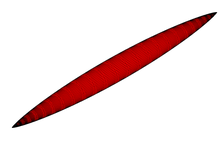Haacksche Ogive
The Haacksche Ogive is a pointed, streamlined body of revolution that is shaped like an ogive in the longitudinal section . This Haacksche Ogive represents the most aerodynamic shape of a supersonic missile in the range from Mach 1.5 to 3. At higher speeds, a Newton-tip shape is advantageous.
history
The Haacksche Ogive was invented by Wolfgang Haack . Haack worked on the gas dynamics of supersonic flows during the Second World War . He found an analytical solution for the aerodynamically most favorable body in the supersonic range, the so-called Haacksche Ogive . His work was published by the Lilienthal Society in 1941. The main aim of this research was to develop better ammunition for sniper rifles that should lose less energy in flight. However, the German war economy was no longer able to implement this knowledge in production. The Haacksche Ogive was later used in the payload fairing of rockets. Work on the perfection of the bullet shapes according to the Haakschen Ogive in conjunction with the Magnus effect continued into the 21st century .
properties
Deviations from the ideal shape influence the drag-dependent range of a projectile or the energy requirements of powered supersonic missiles. The Haacksche Ogive has considerably better aerodynamic properties than the Tangentialogive or even the Secantogive , which are named after their geometrical construction rules . However, the war industry did not succeed in implementing Haack's development in the manufacture of projectiles for sniper rifles in good time before the end of the war.
Ogives also serve as the basis for shaping supersonic projectiles or missiles such as the V2 .
Formulas
To simplify his calculations, Haack assumed that the flow is eddy-free and that there is no ground suction. For this purpose, he found a system of three formulas with which every Haacksche Ogive can be described:
Here are:
- and the coordinates of the tip shape (in parametric representation) with the parameter
- is the peak height
- the volume of the tip
- the caliber cross-sectional area
- the resistance of the tip in relation to the dynamic pressure
- is a continuous parameter from the set of rational numbers
Haack found out that becomes minimal if:
After the insertion, the formula results:
This form has the drag coefficient:
Together with the parametric display of the optimal shape is ready.
The designer now has three changeable sizes available: the caliber ( is included), the tip height and the tip volume. If two sizes are given, the third can be optimized for minimum resistance. In practice, the caliber and length are usually specified, which means that the pointed volume is the size to be optimized (so-called KL bullets).
literature
- Projectile shapes of the smallest wave resistance by Wolfgang Haack (1941) ( Memento from September 27, 2007 in the Internet Archive )
Individual evidence
- ↑ Shapes of the smallest wave resistance ( Memento from September 27, 2007 in the Internet Archive ) by Wolfgang Haack
- ↑ Paul Christmas: VIRTUAL WIND TUNNEL METHOD FOR PROJECTILE AERODYNAMIC CHARACTERIZATION , 2007 (PDF, 211 kB) ( Memento from May 10, 2018 in the Internet Archive )















